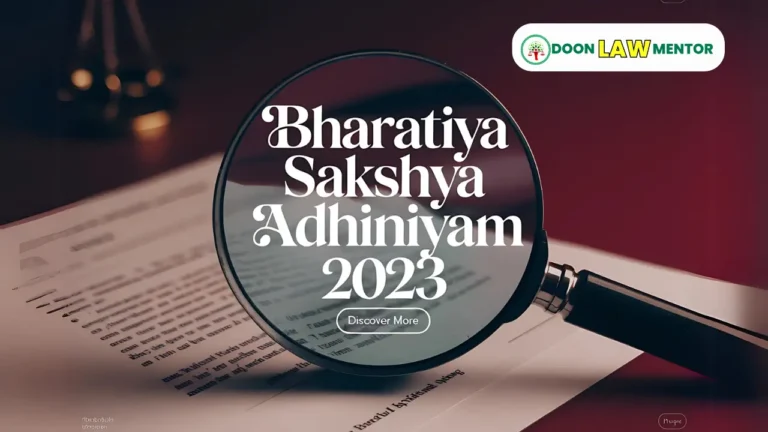What does R. C. Poudyal v. Union of India mean for India’s Constitution? Doon Law Mentor offers a simple guide for law students and lawyers, analyzing the 1994 case on Sikkim’s integration, Article 371F, and constitutional flexibility. Explore key issues, judgments, and lessons for legal practice.
Table of Contents
Introduction
Imagine a small state joining India with its own unique rules and traditions. How does the Constitution handle this? The case of R. C. Poudyal v. Union of India (1994 Supp (1) SCC 324) answers this question, showing how India’s Constitution balances unity with diversity. For fresh law students and new lawyers, understanding R. C. Poudyal v. Union of India is like learning how India respects differences while keeping the nation together. This landmark case, decided in 1994, dealt with Sikkim’s integration into India and special rules under Article 371F. This article, created by Doon Law Mentor, explains R. C. Poudyal v. Union of India in simple language. We’ll cover the case’s background, legal issues, court decisions, constitutional insights, and why it matters for your legal studies or practice, making it easy and engaging to learn.
Understanding R. C. Poudyal v. Union of India
Background of the Case
R. C. Poudyal v. Union of India is about Sikkim, a small state in Northeast India, joining the country in 1975 as the 22nd state. Before 1975, Sikkim was a separate kingdom with its own laws and culture. When it became part of India, the Constitution added Article 371F to give Sikkim special rules to protect its unique identity. These rules included reserving seats in the Sikkim Legislative Assembly for certain groups, like the Sangha (Buddhist monks) and Sikkimese of Bhutia-Lepcha (BL) origin.
In 1993, R. C. Poudyal, a politician, challenged these special rules in the Supreme Court. He argued that reserving 12 out of 32 assembly seats for Bhutia-Lepcha communities and one seat for the Sangha violated the Constitution’s basic rules, like equality and fair elections. The case, R. C. Poudyal v. Union of India, decided in 1994, became a big deal because it tested how flexible India’s Constitution can be when adding new states with different traditions.
Key Facts
- Sikkim’s History: Sikkim was a monarchy until 1975, when it joined India after a referendum. The 36th Amendment added Article 371F to the Constitution, allowing Sikkim to keep some old laws and customs.
- Challenged Law: The Representation of the People Act, 1950, and Sikkim’s election laws reserved seats for Bhutia-Lepcha (12 seats) and Sangha (1 seat), even though these groups were a small part of the population.
- Petitioner’s Claim: R. C. Poudyal said these reservations were unfair and against the Constitution’s principles of equality (Article 14) and democratic elections (Article 326).
- Court: The Supreme Court of India, with a three-judge bench (Justices Kuldip Singh, P.B. Sawant, and N.P. Singh).
Read More: N.M. Sahib Case: Legal Analysis of Pondicherry’s Integration in 1962
Legal Issues in R. C. Poudyal v. Union of India
The case raised big questions about India’s Constitution:
- Does Article 371F allow Sikkim to have special election rules that don’t follow the Constitution’s usual standards?
- Do reserved seats for Bhutia-Lepcha and Sangha violate equality under Article 14?
- Are these reservations against the idea of free and fair elections under Article 326?
- Can the Constitution bend its rules to include a new state like Sikkim with its unique history?
Legal Framework in R. C. Poudyal v. Union of India
The Supreme Court looked at several constitutional and legal provisions to decide R. C. Poudyal v. Union of India. Let’s break them down in simple terms.
1. Constitutional Provisions
- Article 371F: Added in 1975, this article gives Sikkim special treatment. It says Sikkim can keep some old laws and customs, even if they don’t match other constitutional rules. For example, it allows the state to have unique election laws.
- Article 14: Promises equality before the law. Poudyal argued that reserving seats for small groups was unfair to others.
- Article 326: Says elections for state assemblies must be based on adult voting (everyone over 21, now 18, gets a vote). Poudyal claimed the reservations made elections less fair.
- Article 2: Allows Parliament to admit new states into India with conditions. In R. C. Poudyal v. Union of India, this was key because Sikkim joined with special terms.
- Article 368: Lets Parliament amend the Constitution, like adding Article 371F for Sikkim.
2. Representation of the People Act, 1950
- This law sets rules for elections in India. For Sikkim, it allowed reserving 12 seats for Bhutia-Lepcha and 1 seat for Sangha, even though these groups were only about 20% of the population.
- Poudyal argued this broke the “one person, one vote” idea because it gave more power to smaller groups.
3. Bharatiya Nyaya Sanhita, 2023 (BNS)
While R. C. Poudyal v. Union of India was decided in 1994 under the Indian Penal Code (IPC), today, related criminal issues (e.g., fraud or intimidation in elections) would fall under the BNS, effective July 1, 2024. Relevant sections include:
- Section 318: Cheating (up to 7 years in jail). If someone tricks voters during elections, this applies.
- Section 351(2): Criminal intimidation (up to 2 years in jail). Threats to influence voting could be punished here.
- Section 61: Criminal conspiracy. If people plan to rig elections, this section applies.
4. Bharatiya Sakshya Adhiniyam, 2023 (BSA)
The BSA, replacing the Indian Evidence Act, 1872, helps courts use evidence in cases like R. C. Poudyal v. Union of India today:
- Section 61: Electronic records (e.g., election documents) can be used in court if they’re real.
- Section 63: Digital evidence needs a certificate to prove it’s genuine. In election disputes, this helps use records like voter lists.
5. Sikkim’s Election Laws
- Sikkim’s laws, protected by Article 371F, reserved seats based on historical agreements when Sikkim joined India. The court had to decide if these were okay under the Constitution.
Read More: Kelsen’s Grundnorm in India: A Legal Philosophy Analysis for 2025
The Supreme Court’s Decision in R. C. Poudyal v. Union of India
Majority Opinion (Justices Kuldip Singh and P.B. Sawant)
In R. C. Poudyal v. Union of India, the Supreme Court ruled 2:1 in favor of the government, upholding the special election rules for Sikkim. Here’s what they said in simple terms:
- Article 371F Is Special: Sikkim joined India with unique conditions because of its history as a monarchy. Article 371F allows these differences, even if they don’t fully match other constitutional rules like equality (Article 14).
- Reservations Are Okay: The 12 seats for Bhutia-Lepcha and 1 for Sangha were part of the deal when Sikkim joined India. The court said this was reasonable to protect Sikkim’s unique culture and avoid tension between communities.
- Elections Still Fair: The reservations didn’t break Article 326 because all adults could still vote. The court said “one person, one vote” doesn’t mean every vote has equal weight in special cases like Sikkim.
- Constitution Is Flexible: Article 2 lets new states join with special terms. The court said R. C. Poudyal v. Union of India showed the Constitution can bend to include diverse regions without losing its core ideas.
Dissenting Opinion (Justice N.P. Singh)
Justice N.P. Singh disagreed, saying:
- The reservations gave too much power to small groups (Bhutia-Lepcha and Sangha), which was unfair under Article 14.
- The Sangha seat (for monks) mixed religion with politics, which could harm India’s secular nature.
- The election rules went against the idea of equal representation in a democracy.
Final Ruling
The majority upheld the laws, so Sikkim’s reserved seats stayed. R. C. Poudyal v. Union of India became a key case showing how India’s Constitution can adapt to include new states with special needs.
Key Constitutional Insights from R. C. Poudyal v. Union of India
R. C. Poudyal v. Union of India teaches big lessons about India’s Constitution:
- Flexibility: The Constitution can stretch to fit unique situations, like Sikkim’s history, using Article 371F or Article 2.
- Balancing Equality: Article 14 (equality) is important, but special rules for certain groups can be okay if they have a good reason, like protecting culture.
- Federalism: States like Sikkim can have different rules, showing India’s federal system respects diversity.
- Democracy’s Limits: Elections must be fair (Article 326), but “fair” can mean different things in special cases.
- Secularism Debate: The Sangha seat raised questions about mixing religion and politics, but the court allowed it for Sikkim’s unique context.
Case Studies Related to R. C. Poudyal v. Union of India
Case Study 1: State of Nagaland v. Ratan Singh (1966)
- What Happened: Nagaland, another special state, had unique election rules. This case tested if they fit the Constitution.
- Link to R. C. Poudyal v. Union of India: Like Sikkim, Nagaland got special treatment under Article 371A. The court upheld this, setting the stage for R. C. Poudyal v. Union of India.
- Lesson: The Constitution allows special rules for Northeast states to respect their history.
Case Study 2: Union of India v. Association for Democratic Reforms (2002)
- What Happened: This case pushed for fair elections by making candidates share their details.
- Link to R. C. Poudyal v. Union of India: It reinforced Article 326’s focus on fair elections, but R. C. Poudyal v. Union of India showed exceptions are okay for special states.
- Lesson: Democracy is key, but special cases like Sikkim can bend the rules.
Case Study 3: Sikkim’s Recent Election Disputes (2023)
- What Happened: Some groups challenged Sikkim’s election rules again, citing R. C. Poudyal v. Union of India.
- Outcome: Courts referred to R. C. Poudyal v. Union of India to uphold Article 371F, but debates continue about fairness.
- Lesson: The case still shapes Sikkim’s elections today.
Comparative Analysis: Global Perspectives
- Canada: Canada’s Constitution gives Quebec special language and cultural rights, similar to Sikkim’s Article 371F. Courts there balance diversity with equality, like in R. C. Poudyal v. Union of India.
- Australia: Indigenous groups get special representation in some elections, like Sikkim’s Bhutia-Lepcha seats. This shows global constitutions can adapt for minorities.
- United States: No direct equivalent, but Native American tribes have special rights, similar to Sikkim’s unique rules under R. C. Poudyal v. Union of India.
Challenges Highlighted by R. C. Poudyal v. Union of India
- Balancing Equality: Reservations in R. C. Poudyal v. Union of India raised fairness concerns under Article 14.
- Evidence Issues: Today, proving election fraud would use BSA Section 63, needing certified digital records, which can be hard.
- Secularism Concerns: The Sangha seat sparked debates about religion in politics, a sensitive issue in India.
- Public Trust: Some Sikkimese felt the reservations were unfair, causing tension.
- Legal Clarity: Article 371F’s broad power can confuse courts in future cases.
Implications for Lawyers and Law Students
R. C. Poudyal v. Union of India is a goldmine for your career:
- Learn Constitutional Law: Study Articles 371F, 14, 326, and 2 to understand flexibility in the Constitution.
- Master Evidence Rules: Know BSA Sections 61 and 63 for handling election disputes with digital proof.
- Defend Democracy: Use R. C. Poudyal v. Union of India to argue for fair elections while respecting special state rules.
- Protect Diversity: Help states like Sikkim keep their culture through legal advice.
- File Big Cases: Take on public interest cases about election fairness, citing R. C. Poudyal v. Union of India.
Table: Key Legal Provisions in R. C. Poudyal v. Union of India
| Law | Key Rules | Role in R. C. Poudyal v. Union of India |
|---|---|---|
| Constitution | Articles 371F, 14, 326, 2 | Allowed Sikkim’s special rules, balanced equality and elections |
| BNS, 2023 | Sections 318, 351(2), 61 | Could apply to election fraud or threats today |
| BSA, 2023 | Sections 61, 63 | Helps use digital evidence in election cases |
| Representation of the People Act, 1950 | Reserved seats | Upheld as valid under Article 371F |
This table, by Doon Law Mentor, sums up the legal tools in R. C. Poudyal v. Union of India.
Conclusion: Why R. C. Poudyal v. Union of India Matters
R. C. Poudyal v. Union of India shows how India’s Constitution bends to include diverse states like Sikkim while keeping core ideas like equality and democracy. Article 371F’s special rules, upheld in this 1994 case, teach us that India values unity in diversity. For law students and lawyers, this case is a guide to constitutional flexibility, election laws, and protecting rights. Visit Doon Law Mentor at doonlawmentor.com to dive deeper into R. C. Poudyal v. Union of India and boost your legal skills!
FAQs
What is R. C. Poudyal v. Union of India about?
It’s a 1994 case where the Supreme Court upheld Sikkim’s special election rules under Article 371F, balancing diversity and equality.
Why is Article 371F important in this case?
It allows Sikkim to keep unique laws, like reserved seats, as decided in R. C. Poudyal v. Union of India.
How does the case affect equality?
It says special rules for groups like Bhutia-Lepcha are okay under Article 14 if they have a good reason.
Can BSA help in similar cases today?
Yes, BSA Sections 61 and 63 let courts use digital evidence for election disputes.
Why study R. C. Poudyal v. Union of India?
It teaches constitutional flexibility, election laws, and diversity, key for new lawyers.
#RCPoudyalCase #IndianConstitution #Article371F #DoonLawMentor









